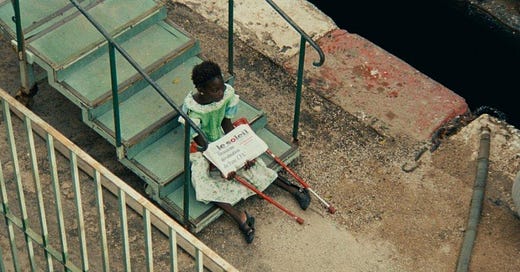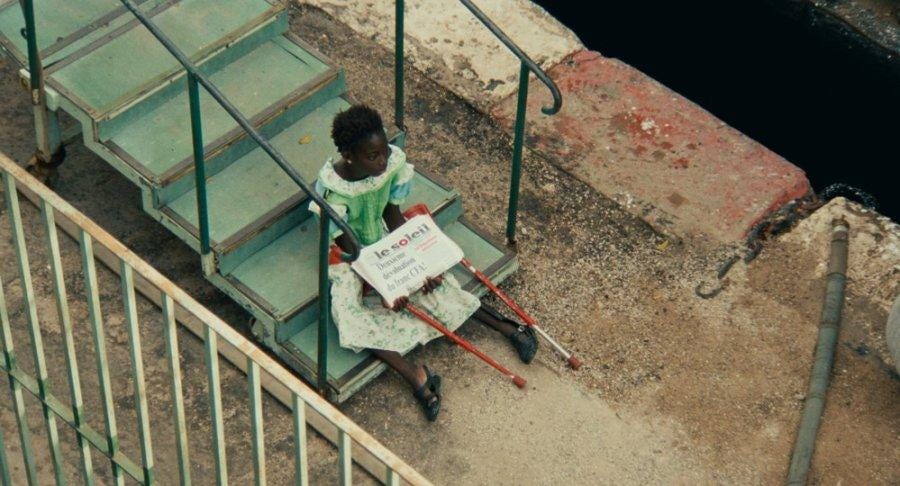I can’t stop thinking about crip cinema.
I’ve been thinking about it for so long, I can’t remember when the fixation started. It might have been when I was seventeen and watching The Fault in Our Stars in the Bishop’s Stortford Empire. A flawed film - still, I sobbed when he got the gastrostomy infection. I hadn’t seen that part of myself in another before. Or maybe the obsession started earlier, when I was seven and newly diagnosed. Still adjusting to my sick body, I sought comfort in the films I could access from home. DVDs and VHS’ piled high next to the TV. Not yet aware what my place in the world as a sick person meant. Not knowing it meant anything at all. It could also have been when I was 22, fired from my first job in the film industry for sitting down too much.
Whatever it was that lit that fire initially, it recently rekindled following discussions with a friend in the industry about the ‘lack’ of it. Aching to see ourselves honestly represented on that big screen we love so dearly, but are time and time again excluded from.
It’s hard to ignore the irony of how much cinema means to the sick (how did you pass the time the last time you were unwell?), when the industry itself seems to hate sick people so much. This conflict at one point led me to wonder if I could stomach cinema any longer. I spent a long time pretending films didn’t mean that much to me. I’m not going to do that now.
There are so many feelings and moments and conversations that have led to the creation of the archive. It is a project that has come together with ease. Each film pulling me further into the spiral, falling deeper and deeper into a cinema of illness. What once seemed an uninhabited genre, near-invisible in contemporary cinematic discourse, now appears to me rich, complex, and abundant.
The archive has been constructed from a myriad of places. Largely, from my bed. Also, from libraries. From the cafes of south east London. Sometimes stopping in because I accidentally pushed myself too far and needed to rest before making my next move. It has been made in stolen moments. Pockets of time where I had enough energy to spend an hour or two thinking, writing, reading, indexing, and crucially - watching.
Watching never feels like stolen time. Never takes energy I don’t have to give, but sometimes returns it anyway. Opening up doors to other worlds when one is feeling (too) firmly rooted in their own. Films are generous in this way.
The Archive
Crip Cinema Archive celebrates the rich and complex history of disabled cinema. Crip cinema is a cinema of resistance. It feels important to collect and value these films. Films that inform the world on who we are as disabled people, what we have to contribute, and what we have contributed to a medium as powerful as the moving image.
I’m conscious of the harm that negative representations of our community on screen have caused, and continue to cause each Oscar season. I’m conscious that most often, this harm is to disabled people more visible than myself. As someone with an invisibilised disability, I am in many ways protected. I hope this archive can offer a different lens through which to view crip cinematic history. That it doesn’t flatten or avoid the complexity, but instead records its abundance and brings it out of the shadows. The impact each film has on disabled people outside the confines of the cinema remains at the forefront of my mind.
The archive defines ‘crip cinema’ as films that speak to something about the crip experience, speak to crip audiences, or that have a crip writer, director, or lead actor.
This definition was inspired by Black Film Archive, created by Maya S. Cade. I hope that by using this, the archive will remain a space for disabled people to feel seen, not spoken down to; a space where we are in on the joke, not the object of one.
I have a few aims for the archive:
To create a resource for disabled filmmakers and film lovers seeking out crip cinema.
To be a launching pad for further discussions about how to define crip cinema; what it is, what it isn’t, and what it could be.
To imagine better crip film futures - in front of and behind the lens - and make them a reality.
It is unfinished - launching with 50 films. My watchlist holds 200 more. At least 50 more I’ve watched and are to be added over the coming months. All of this still only a fragment of what is actually out there. Additions to the archive will be made in crip time, in the stolen moments I mentioned above. I am also welcoming submissions here.
The archive is now live for you to visit. If you’d like to get in touch, you can email me at cripcinemaarchive@gmail.com, or reply to this email.
Access
Crip Cinema Archive is dedicated to accessibility and disability culture. Access is a crucial element to the work. I am striving for access intimacy, and strongly oppose film industry (in)accessibility norms, especially ‘no chair’ policies.
This project is currently unfunded, so the website has not been designed by a professional developer. Because of this, there are accessibility issues across the site. Improving this is a priority as the archive looks toward possible funding routes. Until this is in place, I’ll continue actively working to increase the accessibility and usability of our website.
Feedback is welcomed. If something isn’t working for you, please get in touch.
In the meantime, here are some things in place:
All films we link to will have English captions. We will not link to a film that is uncaptioned.
Where possible, we will also link to audio described (AD) and BSL versions.
All images have alt text, as well as more detailed image descriptions in the captions.
We use plain language as much as possible.
We use structured headings.
We check the colour contrasts for text and backgrounds.
We use descriptive link text.
It should be possible to navigate most of the website using just a keyboard.
Acknowledgements
Crip Cinema Archive would not exist without the work of so many.
Those doing the incredible work of archiving and documenting marginalised film histories, notably Another Gaze, Black Film Archive, June Givanni PanAfrican Cinema Archive, and Otherness Archive.
Conversations with my crip, sick, disabled, and neurodivergent friends - Catriona, Celestine, Emily, Helen, Jenny, Leo, and Otto - and admiring from afar similar thoughts being shared across Instagram and Letterboxd by people like Bec, Grant and Tash.
The many crip, disabled filmmakers, writers, critics, activists, academics, researchers, and teachers who came before and will come after.
And of course, the filmmakers and artists behind the rich, varied films included in the archive.
Thank you all,
Emily





